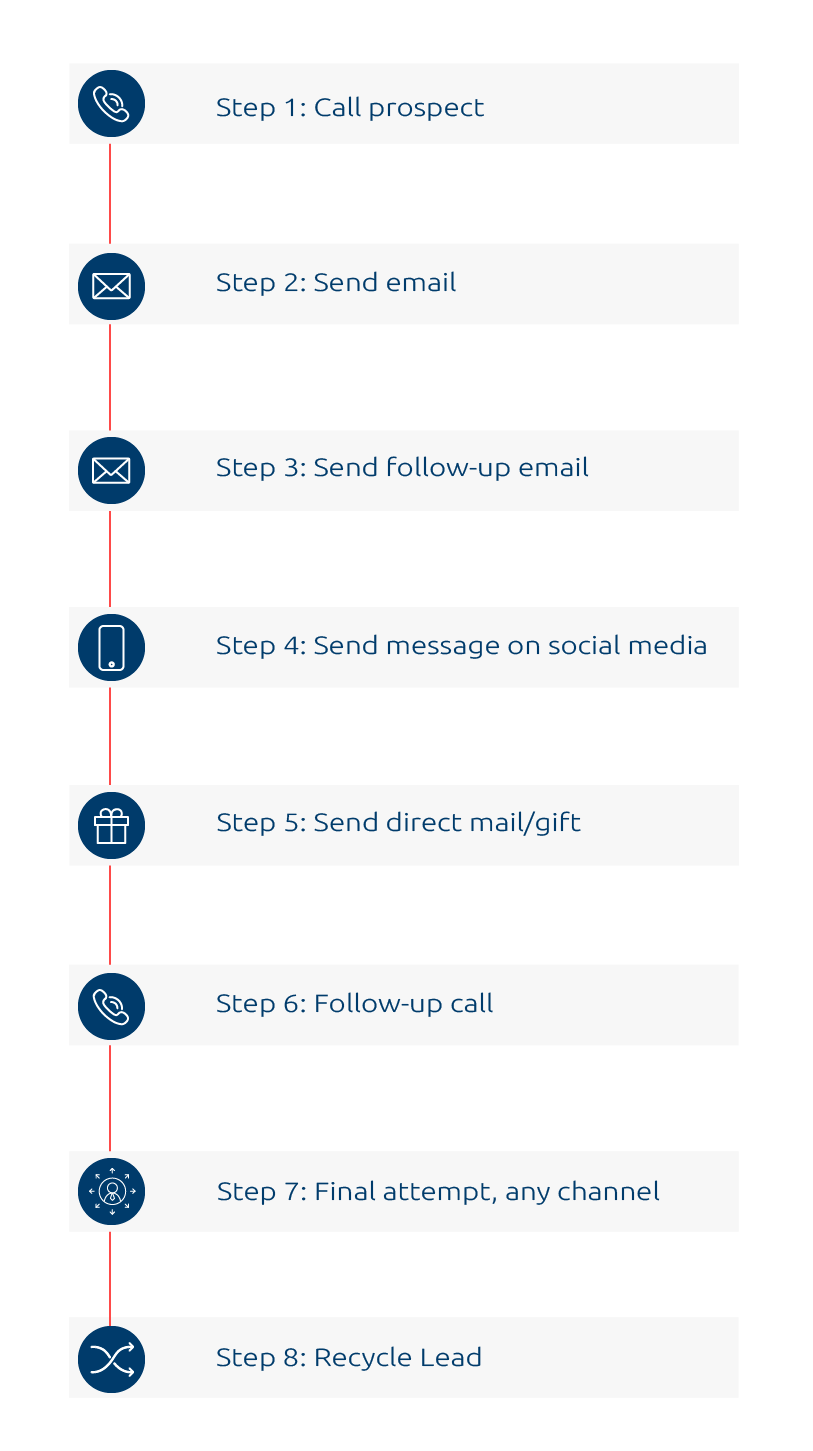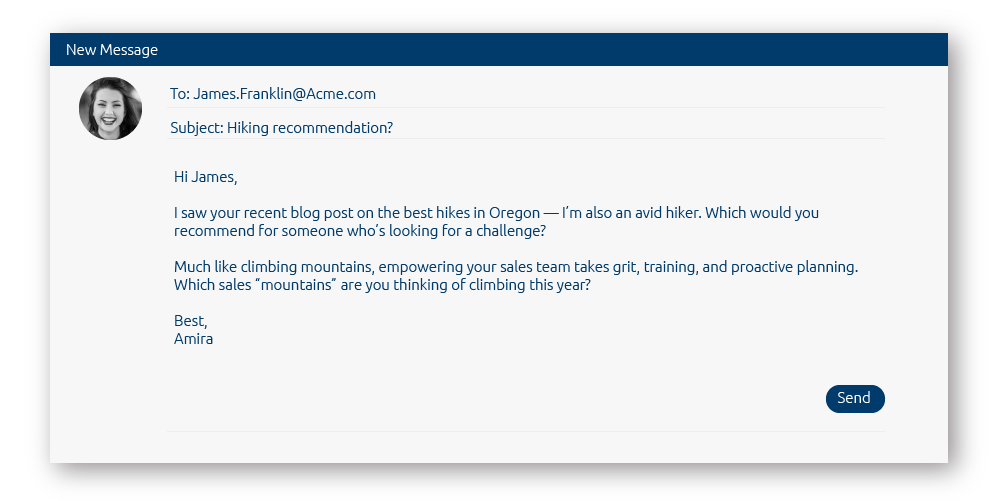This post was originally published in November 2020 and has been updated for accuracy and comprehensiveness.
Connecting with prospects is key to securing new business. But standing out to prospects in our cluttered digital sales landscape is difficult. How can salespeople cut through the noise and drive impactful engagements with prospects?
The answer lies with your sales engagement strategy. Done right, an effective sales engagement strategy will ensure that your sellers know how and when to reach customers, leaving no prospect behind.
In this guide, we’ll break down what makes a sales engagement strategy shine.
What Is Sales Engagement?
Sales engagement refers to all the interactions that take place between a salesperson and a prospect throughout the sales cycle. Today, most interactions take place on calls or online via email or social media, allowing sales organizations to build scalable, multichannel engagement strategies that accelerate revenue growth.
Here’s how it works: Rather than letting salespeople randomly determine how and when to engage customers, sales managers can use data to build a formalized framework that tells salespeople how and when to engage with buyers. This ensures that buyers are receiving the right information at the right stage of their buyer’s journey, and that salespeople keep deals moving forward.
Sales engagement takes many forms. Whether it’s an email you sent, a call you had, a post on social media, they all take the form of sales engagement. Now, you may not need a dedicated sales engagement software or platform to engage with prospects, but it will help you streamline your efficiency and sales outreach. More on that in a bit.
Why Sales Engagement Matters
At its core, sales engagement is about fostering meaningful connections with potential and existing customers. This process is crucial because it goes beyond the transactional aspects of selling and focuses on building relationships.
By actively engaging with customers, sales teams gain valuable insights into their needs, preferences, and challenges. This understanding allows sales professionals to tailor their approach, offering solutions that resonate with customers on a personal level. Effective sales engagement not only drives conversions but also contributes to customer retention and loyalty. Companies that successfully engage customers perform 23% better than their competitors, report 63% lower customer attrition, and achieve 55% higher wallet share.
Sales engagement also helps speed up your onboarding and training for the sales team. By seeing which sequences work best for your target market, you can train your team on the most effective practices.
Sales Engagement vs. Sales Enablement
Though they may sound similar, sales engagement and sales enablement focus on two separate aspects of rep productivity.
Sales engagement is centered on efficiency: most engagement strategies accelerate a rep’s output through a systematic approach to buyer engagement.
Sales enablement, on the other hand, is focused on effectiveness. Sales enablement seeks to ensure that every engagement is impactful by empowering teams with knowledge of what to know, say, show, and do.
Together, sales enablement and sales engagement help scale your sales processes to ensure that every rep, from your SDRs to your account managers, knows exactly how to maximize every customer interaction across the buyer’s journey.
Take a look at how you can integrate your enablement and engagement efforts
What Is Prospect Engagement?
Prospect engagement is a subset of sales engagement, focused on the early stages of the buyer’s journey. When engaging a prospect, salespeople more than ever need to capture and keep buyer attention. Doing so can be achieved with a tested, formalized approach to engaging buyers.
Your exact approach will vary depending on your business. In fast-paced SaaS selling environments, for example, this may mean rapid, frequent communication with buyers across many channels. For more traditional industries, like financial services, engaging prospects might require a slower approach over a longer sales cycle.
Ultimately, tailoring your prospect engagement strategy to your buyers will be key to driving impact.
What Is a Sales Engagement Platform?
A sales engagement platform is an essential part of your engagement strategy. Sales engagement platforms allow you to scale your approach to prospect engagement by guiding rep activities throughout the customer journey.
With the addition of sales engagement tools, you can quickly map out a path for effective engagement across email, direct mail, phone, social media, and other channels. Operating through a platform ensures that the impact of these activities is tracked, allowing businesses to use data to drive decisions around their overall sales strategy.
A good sales engagement platform typically has the following functionality:
-
- Workflow: These features will allow you to scale your engagement strategy
- Email/call sequencing
- Email scheduling
- Outreach templates
- CMS/Email integrations
- Analytics: These features are critical to understanding how your reps and your business is performing
- Open rates/views
- Content engagement activity
- Rep activity
- Calling: These features will boost rep productivity
- Call types
- Click-to-call
- Contacts: These features ensure reps can make smart decisions regarding account-based selling
- Prospect data management
- Account-based selling support
- Workflow: These features will allow you to scale your engagement strategy
A word of caution, however — a sales engagement platform can make it easy to bombard customers with automated emails and inquiries. Be sure your engagement approach up-levels interactions without overwhelming buyers.
Types of Sales Engagement Platforms
Outreach: Primarily focused on providing sales engagement automation. It streamlines communication and outreach efforts, allowing sales teams to efficiently connect with prospects and customers.
SalesLoft: Designed to provide a comprehensive set of tools for sales engagement, combining automation, communication, and analytics to optimize sales workflows. See how SalesLoft integrates with sales enablement platform, Highspot, to bring more personalization to the buyer’s journey.
Salesforce Sales Cloud: Primarily a CRM platform with a strong emphasis on sales engagement. It provides a centralized hub for managing customer relationships, leads, and sales activities.
How to Accelerate Sales with Sales Engagement
Boosting sales through effective sales engagement involves a combination of strategies and tactics. Here are the top six ways to enhance sales using sales engagement:
Personalization: Tailor your interactions to the specific needs and preferences of each customer. Personalized communication, whether through sales emails, calls, or meetings, improves overall customer experience and demonstrates a genuine understanding of the customer’s pain points and positions your product or service as a customized solution.
Multi-Channel Engagement: Implement a multi-channel approach to reach customers at various touchpoints. Utilize email, phone calls, social media, SMS notifications, and in-person interactions to create a comprehensive engagement strategy. This ensures that you engage buyers through their preferred channels, increasing the likelihood of a closed deal.
Leverage Sales Enablement and Sales Playbooks: Without an intent to invest in sales enablement holistically, sales engagement can fall short and not generate the desired impact and results. Lean on sales enablement to develop and utilize sales playbooks that provide a structured guide for sales representatives. These playbooks should include best practices, objection handling techniques, and key messaging points. Having a well-defined playbook empowers sales team members to navigate conversations more effectively and consistently.
Automation Tools: Integrate automation tools into your sales process to streamline repetitive tasks and enhance efficiency. Automation can be used for tasks such as email follow-ups, lead nurturing, data tracking, and other sales cadences. This allows sales representatives to focus on high-value activities and building relationships.
Content Strategy: Develop a compelling content strategy that aligns with the buyer’s journey. Provide valuable and relevant content that educates and addresses customer concerns at different stages of the sales cycle. Well-crafted content positions your brand as an authority and helps move prospects through the sales funnel.
Data-Driven Decision Making: Leverage data and analytics to inform your sales engagement strategy. Analyze key performance indicators (KPIs) such as conversion rates, response times, and customer feedback. Data-driven insights enable you to make informed decisions, refine your approach, and continuously optimize your sales strategy for better results.
An effective sales engagement campaign will accelerate sales by providing an outreach framework to guide salespeople throughout the sales process. Just look at the example sales sequence below.

These sequences can be built to guide salespeople through any sales process: first sale, renewal, upselling, and cross-selling.
But be sure to emphasize that these frameworks, especially if automated, are just that — frameworks: as salespeople engage with buyers, it’s important to monitor their response. If a lead expresses negative sentiments at any stage, it’s better to back off and save the relationship than push through with the sequence.
Best Practices for Effectively Engaging Prospects
Now that you have an understanding of what sales engagement is and why it matters, it’s time to start building your sales engagement strategy. Use the tips below to create an impactful program that accelerates sales and grows your business.
Align with Marketing
Much of your engagement strategy will be supported by marketing-created content. These are the assets that your salespeople will send via social media or email. Therefore, it’s essential that you have sales and marketing alignment to ensure that you have visibility into what’s being created, but also that it supports your team’s needs.
The easiest way to do this is by setting up a recurring meeting where marketing reviews their upcoming content strategy and editorial calendar. This will ensure that you can offer timely feedback and prepare your teams to make the most of this content when it launches.
Invest in Technology
As with any element of your sales strategy, the right tools make it that much easier for you to achieve your goals. To effectively implement your sales engagement strategy at scale, investing in many tools like a CRM, as well as a sales engagement and a sales enablement platform is important.
A sales engagement platform will allow you to rapidly build, optimize, and analyze your sales engagement strategy. A sales enablement platform, on the other hand, will ensure your reps have the content, training, and guidance they need to respond to buyers effectively. A CRM will give you insights into real-time engagement and activity with your leads.
Personalize Everything
With powerful technology also comes great responsibility: The ability to automate workflows can tempt salespeople to send flurries of templated emails. But this is a sure path for failure — buyers not only want but expect personalized communications and insights from salespeople.
Ensure your teams don’t make this mistake by building space for personalization into email templates. A simple solution is to include “{Personalize}” as a reminder at the beginning of templates, after the greeting. But the importance of personalization should also be reinforced via coaching sessions, sales plays, and team syncs.
Continuously Optimize
The work doesn’t end once you’ve launched your sales engagement strategy: Once reps have adopted your sequences and are using the required platforms to engage buyers, your mindset should shift from “launch” to “optimize.”
This requires diving deep into your sales engagement and enablement platform analytics. Look at both high-level metrics – such as cumulative open rates, view times, or number of SQLs – as well as individual-level performance metrics. This will help you understand the impact of your sales engagement strategies and identify opportunities to support poor performers.
Get Creative
Finally, every sales engagement strategy should leave room for fun. Buyers are human, after all, and a hyper-personal outreach effort can make the difference between a recycled lead and a won deal.
Lean into creative engagement approaches, such as sending personalized gear, or gift cards to local coffee shops or restaurants. Creative touches don’t have to be purely monetary either – a fun reference to a pop culture moment or something a buyer shared on LinkedIn can also be effective, like the example below.

Grow Your Business with Sales Engagement
With the right sales engagement strategy and tools in place, you can ensure that every sales rep is maximizing their performance and moving your business forward.
Strengthen your sales engagement strategy with Highspot, the world’s leading sales enablement platform. Highspot integrates with some of your most favorite tools to bring more personalization and efficiency to the sales process.




